Rapid report of seismic damage to hospitals in the 2023 Turkey earthquake sequences
Zhe Qu , Feijian Wang , Xiangzhao Chen , Xiaoting Wang , Zhiguang Zhou
a Key Laboratory of Earthquake Engineering and Engineering Vibration, Institute of Engineering Mechanics, China Earthquake Administration, Harbin,150080, China
b Key Laboratory of Earthquake Disaster Mitigation, Ministry of Emergency Management, Beijing, 100054, China
c College of Civil Engineering, Tongji University, Shanghai, 200092, China
Keywords:
ABSTRACT The seismic performance of medical systems is crucial for the seismic resilience of communities.The report summarizes the observed damage to twelve hospital buildings in the area affected by the MW 7.8 and MW 7.5 earthquakes on February 6, 2023 in Turkey.They include five base-isolated buildings and seven fixed-base buildings in southcentral Turkey's seven most heavily affected provinces.By relating the post-quake occupancy statuses of the hospitals with the estimated seismic demands during the earthquake doublet, the report offers the following observations: ① the base-isolated hospital buildings on friction pendulum bearings generally exhibited superior performance of achieving the goal of immediate occupancy and provided better protection for nonstructural elements than fixed-base counterparts did; ② the fixed-base hospital buildings of reinforced concrete structures constructed after 2001 successfully achieved the goal of collapse prevention even under very high seismic demands; ③ some fixed-base hospitals also remained operational even if they were very close to the fault rupture and were subjected to higher-than-design-level earthquake ground motions.
1.Introduction
AnMW7.8 earthquake struck south-central Turkey and northwestern Syria in the early morning on February 6,2023.Approximately 9 hr later,anotherMW7.5 earthquake struck the nearby area in Kahramanmaras¸Province (USGS, 2023).The epicenters of the two quakes were approximately 100 km away from each other.As of March 20, 2023, the earthquake doublet and their aftershocks had led to confirmed deaths of more than 50 000 in Turkey and 7 200 in Syria(Cumhuriyet,2023).As the largest in Turkey since the 1939 Erzincan earthquake(USGS,2023),the earthquake doublet affected at least 13.5 million people, which accounts for approximately 16% of the population of Turkey (Hinshaw et al.,2023),and destroyed approximately 520 000 apartments in Turkey(VOA news,2023).
With the assistance of the Turkey Disaster and Management Authority(AFAD), the China Earthquake Administration dispatched a reconnaissance team of structural and earthquake engineering experts to the affected area in Turkey from March 24-30,2023.The team conducted a field survey of building and infrastructure damage in the seven most heavily affected provinces in southcentral Turkey, including Adana,Adıyaman,Gaziantep,Hatay,Kahramanmaras¸,Malatya,and Osmeniye.
Acknowledging the crucial importance of the seismic performance of medical systems during and after earthquakes for the seismic resilience of a community(Cimellaro et al.,2010;Sato et al.,2011;Santarsiero et al.,2019; Shang et al., 2023), the team visited 12 hospitals across the earthquake-affected area during their 7-day field survey.These included 5 base-isolated buildings and 7 non-isolated conventional reinforced concrete frame buildings.This report summarizes the visual observations on the seismic performance of these hospitals with a special focus on the post-quake service status.
Section 2 summarizes the basic facts of the hospital buildings of concern in this report, and endeavors to relate their post-quake occupancy status with the respective seismic demand during the earthquake doublet.The visual observation of the seismic performance of each hospital,along with the nearby strong motion records,is then introduced in two categories: base-isolated buildings in Section 3, and fixed-base buildings in Section 4.
2.Overview of the investigated hospital buildings
Fig.1 depicts the locations of the 12 investigated hospital buildings along with the epicenters, fault ruptures of the earthquake doublets(USGS, 2023), and strong motion stations (AFAD, 2023) in the region.Each hospital is labeled with a capital letter and a number.The capital letter‘B’indicates a base-isolated building while‘F’indicates a fixed-base building.The five hospitals in the northern part of the affected area were influenced more by theMW7.5 event.Among them, B1,B2,B3, and F1 were in Malatya Province,while B4 alone is in Kahramanmaras¸Province.The other seven hospitals in the southwestern part of the affected area were affected more by theMW7.8 event.While F2 and F3 were in Gaziantep Province,the rest five hospitals were all located in Hatay Province.Among them,F2,F3,F4,and F5 were located within 2 km from the fault rupture.In particular, F3 was only approximately 50 m from a surface rupture.

Fig.1.Locations of hospitals of concern in this report and strong ground motion stations in the earthquake-affected area.
Table 1 summarizes the basic information of the 12 investigated hospital buildings.All buildings have no more than 10 stories.The number of beds ranges from 25 beds in the Nurdăgi State Hospital(Nurdăgi District State Hospital, 2023) to 1 130 beds in the Hatay Education and Research Hospital,which is also the largest hospital in Hatay Province (Hatay Education and Research Hospital, 2023).They are all state-owned public hospitals.
Except for F6 and F7,most hospitals of concern were constructed after 2001, when the seismic design regulations for buildings in Turkey are considered to have undergone a major improvement(Akkar et al.,2018;Binici et al., 2023).All five base-isolated hospital buildings were constructed after 2013 when the government mandated all new hospitals of 100 beds or more in seismic regions to adopt seismic isolation (Erdik et al.,2015,2018;Dilsiz et al.,2023).
The observed occupancy statuses of the 12 hospitals are also listed in Table 1.The status is classified as immediate occupancy(IO),occupancy suspended (OS), and no access (NA).Although the status was based on the observations on the day of investigation, which was about 7 weeks after the earthquake doublet, they roughly represent the occupancy statuses immediately after the quakes according to the managers of the hospitals.
Except for B3 in Doğans¸ehir, all the investigated base-isolated buildings were immediately occupiable after the earthquakes.The possible reasons for B3 to fail to meet the IO performance goal will be discussed later in this report.For the fixed-base buildings,F3 and F4 met the IO goal despite their closeness with the fault rupture.The service of F1 and F2 was suspended after the quakes because of extensive nonstructural damage, as will be introduced in detail in the following sections.
The observed occupancy status of a building needs to be related to the seismic demand for the specific building during the earthquake to properly interpret the seismic performance of the building.To this end,we define a demand ratio,DR, to approximately capture the actual seismic demand imposed on the building.It is the ratio of the recorded spectral acceleration of a representative nearby strong motion recordSa,recand that of the 10%-in-50-years design spectrum(DD2)Sa,DD2in the 2018 Turkish code for the seismic design of buildings (TBDY-2018,2018).The dense array of strong motion observations in the investigation area (Shao et al., 2023) made it possible to select a nearby record of strong motion as the representative earthquake input for most of investigated buildings.
Because of the absence of information on the period of the buildings,the demand ratio is calculated based on estimated periods or period ranges.For fixed-base building, as given in Eq.(1), the ratio is taken at the fundamental period of the buildingT1estimated by its total height and the empirical equation for reinforced concrete (RC) frames in the Turkish seismic code (Eq.(3), TBDY-2018, 2018).For base-isolated buildings, the isolation period is predominated by the design of the isolation layer rather than the properties of the superstructure.Since there is not yet an empirical equation for proper estimation of the isolation period, we take the averaged spectral accelerations in the range ofT= 2 s and 3 s in evaluating the demand ratioDR(Eq.(2)) for the base-isolated buildings.The period range is common for base-isolated multi-story RC buildings (Pan et al., 2005; Cimellaro et al., 2010).
whereSa,rec(T) is the geometric mean of the recorded spectral acceleration of the two horizontal components of the representative ground motion near the building's site;Sa,DD2(T) is the design spectral acceleration at the DD2 level (10% exceedance probability in 50 years, assumingly Site class ZB)as per the 2018 TBDY code(TBDY-2018,2018);T1is the estimated fundamental period of the building by Eq.(3).
whereHis the total height of the building above the ground.It is estimated by assuming a uniform story height of 3.6 m for all the buildings.Ctis an empirical coefficient for structural systems.It is taken as 0.07 as per the code for ‘other structures’ because it is consistent with the suggestion by Yakut(2008)for RC frame buildings based on monitoring data of constructed buildings.WhenCt=0.07,the estimated period by Eq.(3)is also very close to that estimated by the empirical equation in ASCE/-SEI7-2016(2016).
Fig.2 illustrates the calculation ofDRfor fixed-base and base-isolated buildings in this study.It approximately describes how the actual ground motion in the earthquakes exceeded the DD2 level design demand for a specific building.The thus-determinedDRs are listed in Table 1.It should be noted that these demand ratios are subjected to the uncertainty of several sources: (1) although the strong motion observation array is dense, there was not always an available record close enough to all the hospital buildings of concern; (2) even if there was a nearby strong motion record,it may not exactly represent the actual earthquake input for the corresponding building because of the possible effects of local terrain and soil condition; (3) the fundamental periods of the buildings are only rough estimates;(4)the design spectra were based on the latest seismic code in Turkey published in 2018, while many investigated hospital buildings were designed and constructed before it.
Bearing these uncertainties in mind, we plotted the observed occupancy statuses of the 12 hospital buildings against their respective demand ratios in Fig.3 to provide an approximate global picture of how strong the actual ground motions were in comparison with the design demand during the earthquake doublet, and how the buildings performed under such ground motions in terms of the post-quake occupancy.
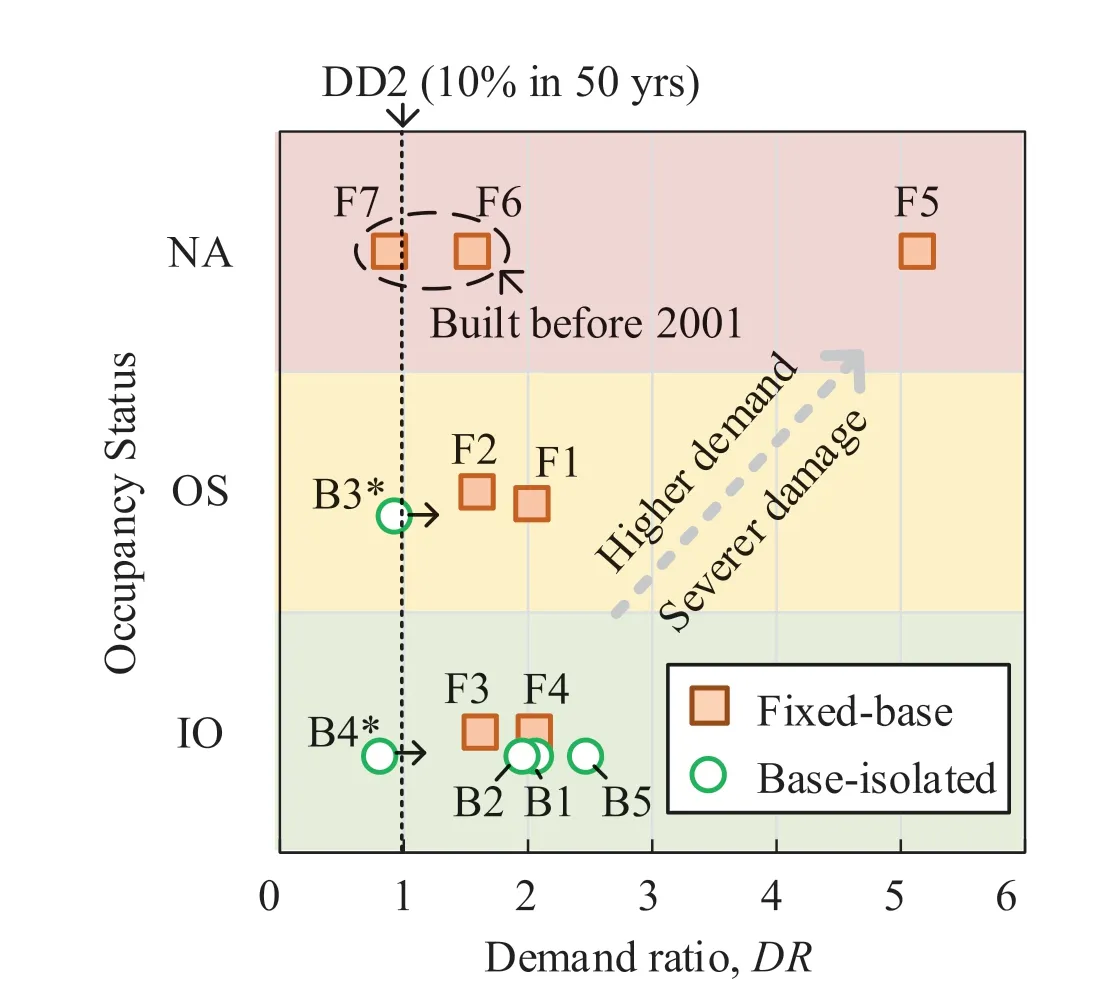
Fig.3.Relationship of post-quake occupancy status and demand ratios of investigated hospitals (* low confidence for lack of nearby strong motion records, likely to have been exposed to much higher demand).
Several observations can be made based on Fig.3: (1) The seismic demand for most investigated buildings exceeded their respective designbasis level (DD2) earthquake.Considering that the DD1 level (i.e., 2%probability of exceedance in 50 years)is approximately 2 times the DD2 level in the latest Turkish seismic code (TBDY-2018, 2018), the seismic demands for five investigated buildings also exceeded the maximum-considered-earthquake level of intensity.
(2) Except B3, most base-isolated buildings successfully guaranteed immediate occupancy under a higher-than-design-level seismic intensity.It was not exclusive to base-isolated buildings.F3 and F4 provided successful examples of fixed-base hospital buildings remaining operational even if they were subjected to stronger-than-design-level shaking.
(3)The extents of damage to most fixed-base buildings did not show a clear positive correlation with the demand ratios.The demand ratios of F1 to F4 and F6 were all around 1.5 to 2 but their post-quake occupancy statuses varied a lot.As will be introduced in Section 4,the malfunction of F3 and F4 was attributed to nonstructural damage.Constructed after 2001,none of the buildings F1 to F4 sustained visible structural damage during the earthquake.The partial collapse of F6 was probably attributed to its old age of more than 50 years.
In the following sections, we introduce the observations on the 12 hospital buildings in details.
3.Base-isolated hospital buildings
3.1. Direct comparison for the effect of seismic isolation: B1, F1 and B2
Four of the five investigated base-isolated hospital buildings are in the northern part of the earthquake-affected regions (Fig.4).In this area,building damage was attributed more to theMW7.5 event than to the proceeding and more destructiveMW7.8 event.The strong motion stations are not as densely distributed as in the southwestern part of the earthquake-affected region, and many stations lost the power supply during the first event and failed to obtain a record in theMW7.5 event.Nonetheless, B1 and F1 on the same campus (Fig.5(a) and (c)) provide a unique chance for a direct comparison between the seismic performance of base-isolated and fixed-base hospital buildings.
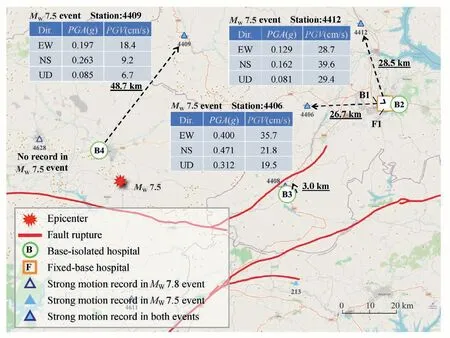
Fig.4.Investigated hospitals in the northern part of the earthquake-affected region and the nearby strong motion stations.
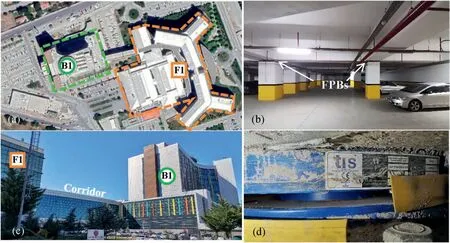
Fig.5.B1 and F1 in Malatya:(a)aerial view(Google Maps),(b)isolation layer in the underground parking lot of B1,(c)photo of north view,(d)friction pendulum in the isolation layer of B1.
B1 was a base-isolated building constructed in 2019.Its main block has 7 stories above ground.It hosts the Malatya Maternity and Children's Hospital which has 331 beds.The isolation layer is in the basement,which is occupied as the parking lot (Fig.5(b)).The isolation layer consists of 246 friction pendulum bearings (FPBs) (Fig.5(d)) with a plus/minus 360 mm design stroke (TS, 2023a).The FPBs were installed on top of stout RC columns.Next to B1 is the fixed-base building F1 of the Malatya Education and Research Hospital with 1 055 beds, which was built in 2009.The two buildings are connected through a fixed-base corridor (Fig.5(c)).
Within 30 km from the hospital campus, there are two strong motion stations, 4412 and 4406, that obtained records in both events.Their locations and the peak values in theMW7.5 event are shown in Fig.4.Closer to the epicenter and the fault rupture, Station 4406 captured much larger peak ground acceleration (PGA) in all directions than Station 4412 did in the same event.The response spectra as shown in Fig.6 confirm that the 4406 record was much richer in short-period contents than the 4412 record.At the estimated fundamental period of F1, the spectral acceleration of the 4406 record slightly exceeded the DD1 level design spectrum and is 2.03 times the DD2 level design spectrum [Fig.6(a)].On the other hand, although exhibited low peak values and poor contents in the short period range, the 4412 record was on a soft site (Class ZC as per TBDY-2018, 2018) and rich in long-period contents.The average spectral acceleration within 2 3 s slightly exceeds the DD1-level design spectrum and is 2.1 times the DD2-level spectrum [Fig.6(c)].
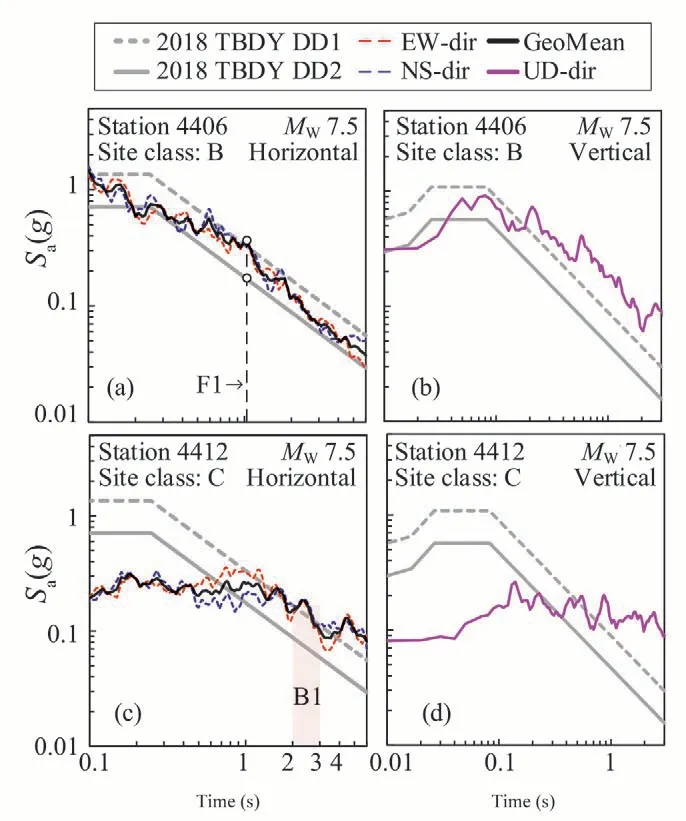
Fig.6.Response spectra of the representative ground motions for F1 in (a)horizontal and (b)vertical directions, and these for B1 in(c) horizontal and(b)vertical directions (5% damping).
If taking the 4406 and 4412 records as the representative ground motion input for the fixed-base F1 and base-isolated B1, respectively,both buildings had very similar demand ratiosDRof 2 during theMW7.5 event.It approximately corresponds to an equivalent DD1-level shaking in terms of spectral acceleration.Although the primary structures of both buildings remained intact under such shaking,both B1 and F1 sustained nonstructural damage to various extents.For B1, the nonstructural damage was slight, was present only in and surrounding the isolation layer,and did not hinder the service of the hospital.Visually significant damage in the isolation layer included the extensive cracking of masonry infills in the underground parking lot that might have hindered the movement of the isolation layer during the earthquakes (Fig.7(a) and(b)),and the dislocation of sealing metal plates surrounding the isolators(Fig.7(c)).The pipes that went through the isolation layer were well protected by the flexible joints (e.g., Fig.7(d)) and remained intact during the earthquake.
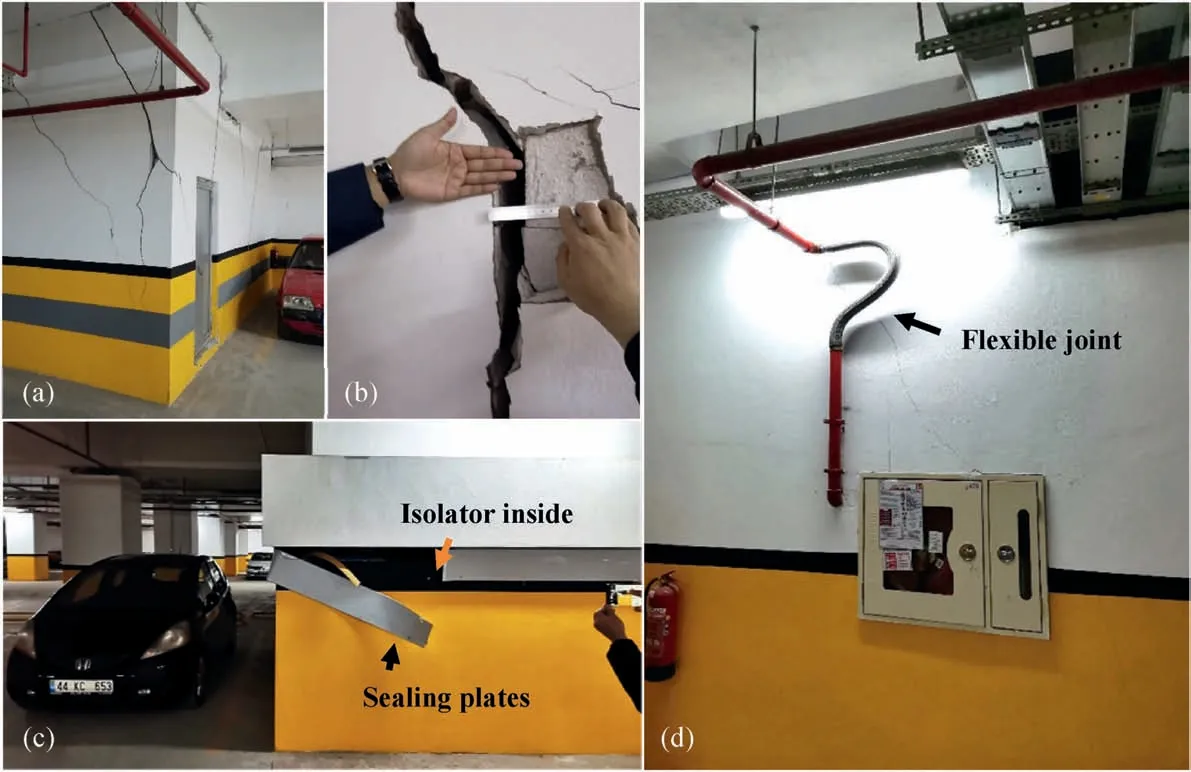
Fig.7.Observed nonstructural damage in the isolation layer of B1:(a)and(b)extensive cracking of masonry infills,(c)dislocated sealing plates,and(d)an example of an intact flexible joint for a fire hydrant.
Surrounding the isolation layer,the most significant damage was the complete falling of the metal cover plates over the isolation gap between B1 and the corridor and a segment of the dry hanging curtain wall(Fig.8(a)).Other damage surrounding the isolation layer included the cracking of the concrete rampway to the main entrance (Fig.8(b)) and the dislocation of some segments of the metal sealing plates over the isolation interface(Fig.8(c)).

Fig.8.Nonstructural damage around the isolation layer of B1: (a) cover plates fell into the isolation gap, (b) concrete rampway cracked, (c) metal sealing plates dislocated.
Unlike B1, the fixed-base building F1 (Fig.9(a)) sustained extensive nonstructural damage in its superstructure.Its occupancy has been suspended since the earthquakes.This contrasts with the satisfying performance of the base-isolated B1 that was on the same campus and was very likely to have experienced the same shaking.Although the damage to F1 was only nonstructural, its occupancy remained suspended when we visited on March 30,52 days after the earthquake doublet.The manager of the hospital said that they sent workers to repair the damaged nonstructural elements after the earthquake doublet, but during an aftershock,the workers in the building were scared by the violent shaking of the building to fled from the building and refused to enter the building anymore.The recovery of the building seemed impossible in the near future.
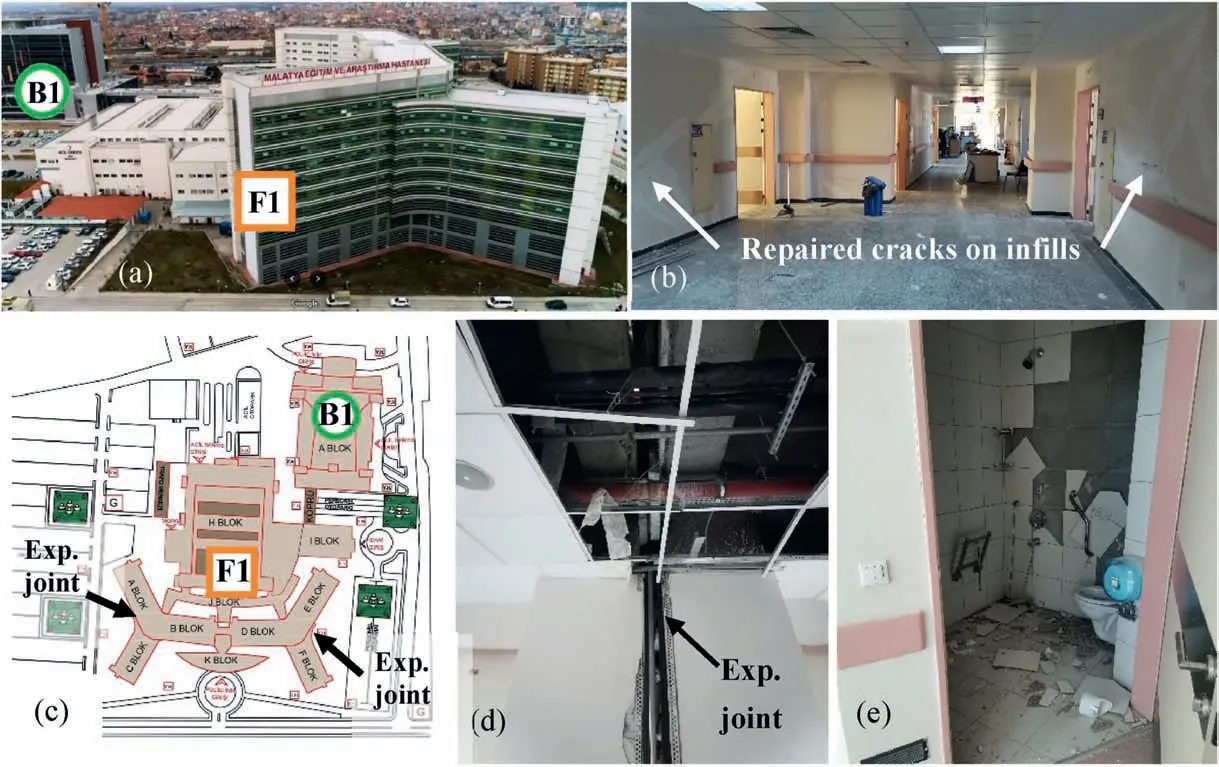
Fig.9.Nonstructural damage in the superstructure of F1: (a) ariel view of F1(Google Maps), (b) cracked masonry infills under repair, (c) plan view of F1 and B1 (Malatya Eğitim Ve Aras¸tirma Hastanesi, 2023), (d) damage near the expansion joints, and (e) falling tiles of a toilet.
The nonstructural damage in Building F1 included the extensive cracking of masonry infills (Fig.9(b)), damage to suspended ceilings(Fig.9(d)),and the falling of ceramic tiles(Fig.9(e)).The cracks on the masonry infills in the lower stories of the buildings were partially repaired before the workers fled from the building in an aftershock.Suspended ceiling damage was concentrated near the expansion joints between the different blocks of the multi-winged building(Fig.9(c)).
Approximately 5 km to the east of the campus of B1 and F1 was another base-isolated hospital building B2 of the Battalgazi State Hospital.It was constructed in 2020 and has 7 stories above ground(Fig.10).Its superstructure was protected by an isolation layer of 220 FPBs with a design stroke of plus/minus 450 mm(TS,2023b).
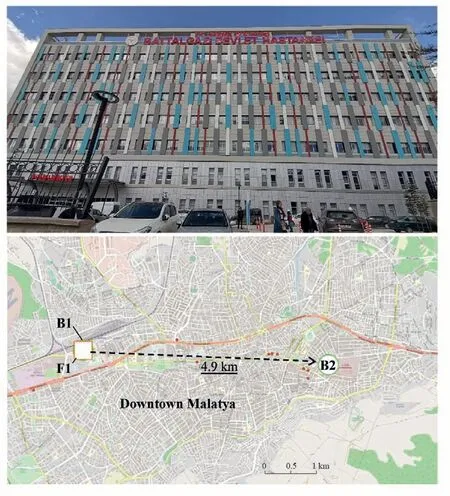
Fig.10.Facade and location of the base-isolated hospital building B2 of the Battalgazi State Hospital.
The isolation layer was in the underground parking lot, where the FPBs were installed on top of stout RC columns.Unlike the cantilever columns that support the FPBs of Building B1, these columns had flat beams framing into them to restrain the rotation of the upper ends(Fig.11(a)).No damage,either structural or nonstructural,was observed in the hospital building, and the hospital was allegedly immediately occupiable after the earthquakes.However, along with the satisfying performance of this building there were no signs of considerable sliding of the isolation layer.The scattered paint on the FPBs remained undisturbed (Fig.11(b)), the masonry infill that may have blocked the isolation layer remained intact (Fig.11(c)), and the cover plate at the main entrance seemed to have not moved(Fig.11(d)).Possible reasons for the satisfactory performance of the building with a seemingly uninitiated base-isolation layer may include the local terrain effect that may have attenuated the ground motion and the smaller scale of the building as compared to the partially damaged building F1.Thorough investigation is deemed necessary to understanding the behavior, which is out of the scope of this rapid report.
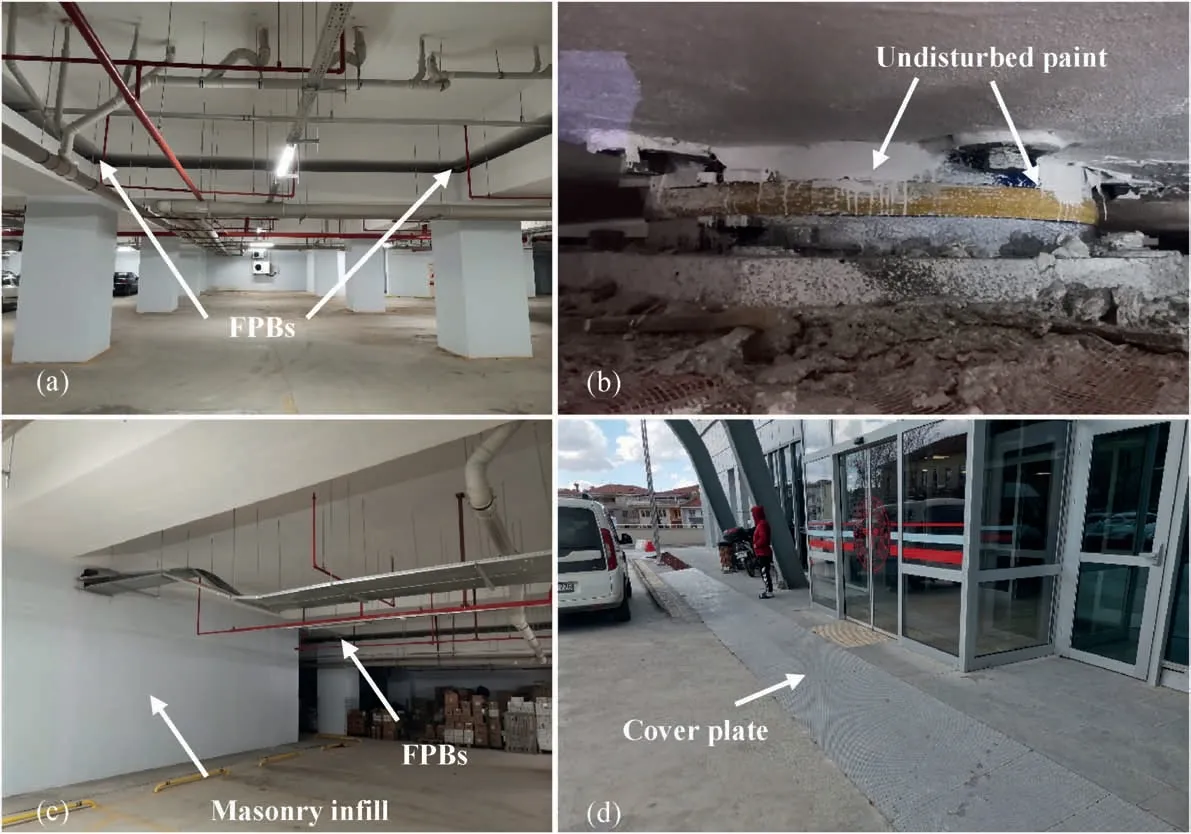
Fig.11.Isolation layer of B2:(a)location of FPBs,(b)an FPB with undisturbed paint,(c)intact masonry infill in the isolation layer,and(d)intact cover plate over the isolation gap.
3.2. A negative example of a blocked isolation layer: B3
Also located in Malatya Province was Building B3 of the Doğans¸ehir State Hospital in the small city of Doğans¸ehir.It was approximately 123 km from the epicenter of theMW7.8 earthquake and 57 km from theMW7.5 earthquake,and only 4.3 km from the fault rupture of the latter event.There was a strong motion station, Station 4408, approximately 3 km from the hospital [Fig.12(a)].According to the response spectra of the 4408 record in Fig.12(b), the isolated hospital experienced approximately DD2-level shaking during theMW7.8 event.TheDRwas 0.92.The hospital building B3 was very likely to have experienced much stronger shaking during theMW7.5 event that followed.Unfortunately, Station 4408 failed to obtain a record during the latter event because of the blackout as a result of the former event.
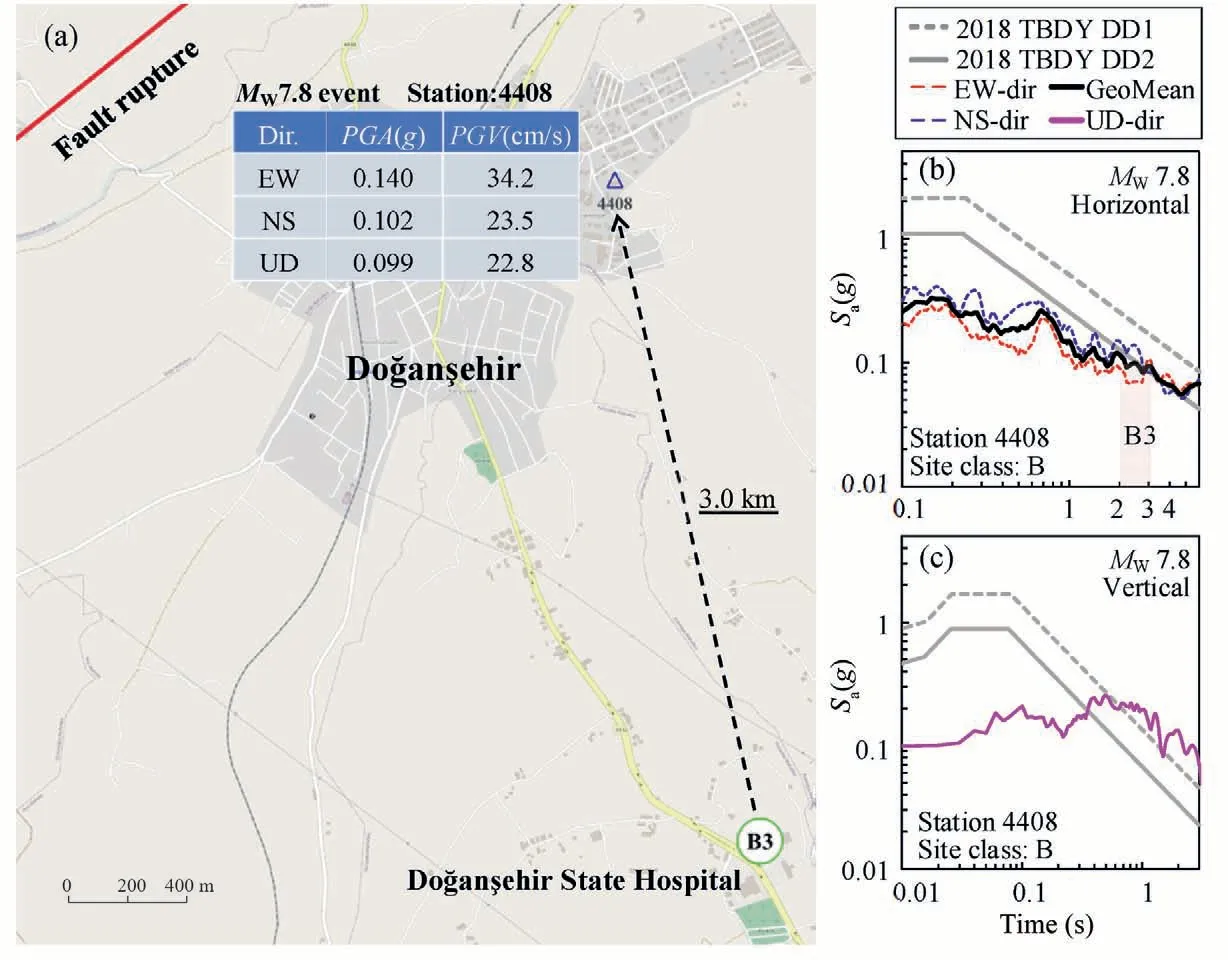
Fig.12.(a) Locations of B3 of the Doğans¸ehir State Hospital and nearby strong motion station 4408, the response spectra of the 4408 record in the MW 7.8 event in (b) horizontal and (c) vertical directions (5% damping).
The 6-story hospital building B3 was constructed in 2019(Fig.13(a)and(b)).The isolation layer constituted a separate story of small height at the base of the building that did not serve any building function(Fig.13(c)).The isolator consisted of 122 FPBs of a design stroke of plus/minus 490 mm(Fig.13(d)).Their vertical load-bearing capacities ranged from 730 to 1 250 tons depending on their diameters(TS, 2023c).
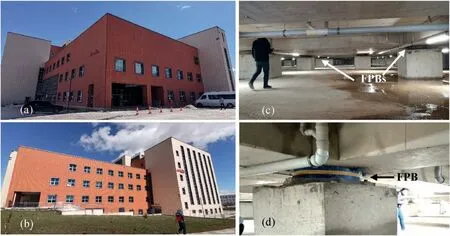
Fig.13.Base-isolated building B3 of the Doğans¸ehir State Hospital:(a)front view,(b)back view,(c)basement that hosts the isolation layer and(d)friction pendulum bearing in the isolation layer.
The isolation gap around the building was being excavated when we visited (Fig.14(a) and (b)) allegedly upon the request of the structural engineers who inspected the building after the earthquake and found that the moat was improperly refilled and suspected that the isolation layer has been blocked during the earthquakes.The underground isolation layer was partially flooded, suggesting possible leakage of some pipes(see Fig.13(c)).A long cable tray in the isolation layer fell because of the failure of its supports of thin steel angles(see Fig.14(c)).There were also signs of poor construction quality in the isolation layer.At the diagonal construction joints in multiple concrete beams over the isolator, longitudinal rebars were exposed and styrofoam blocks were found to remain in the concrete(Fig.14(d)).
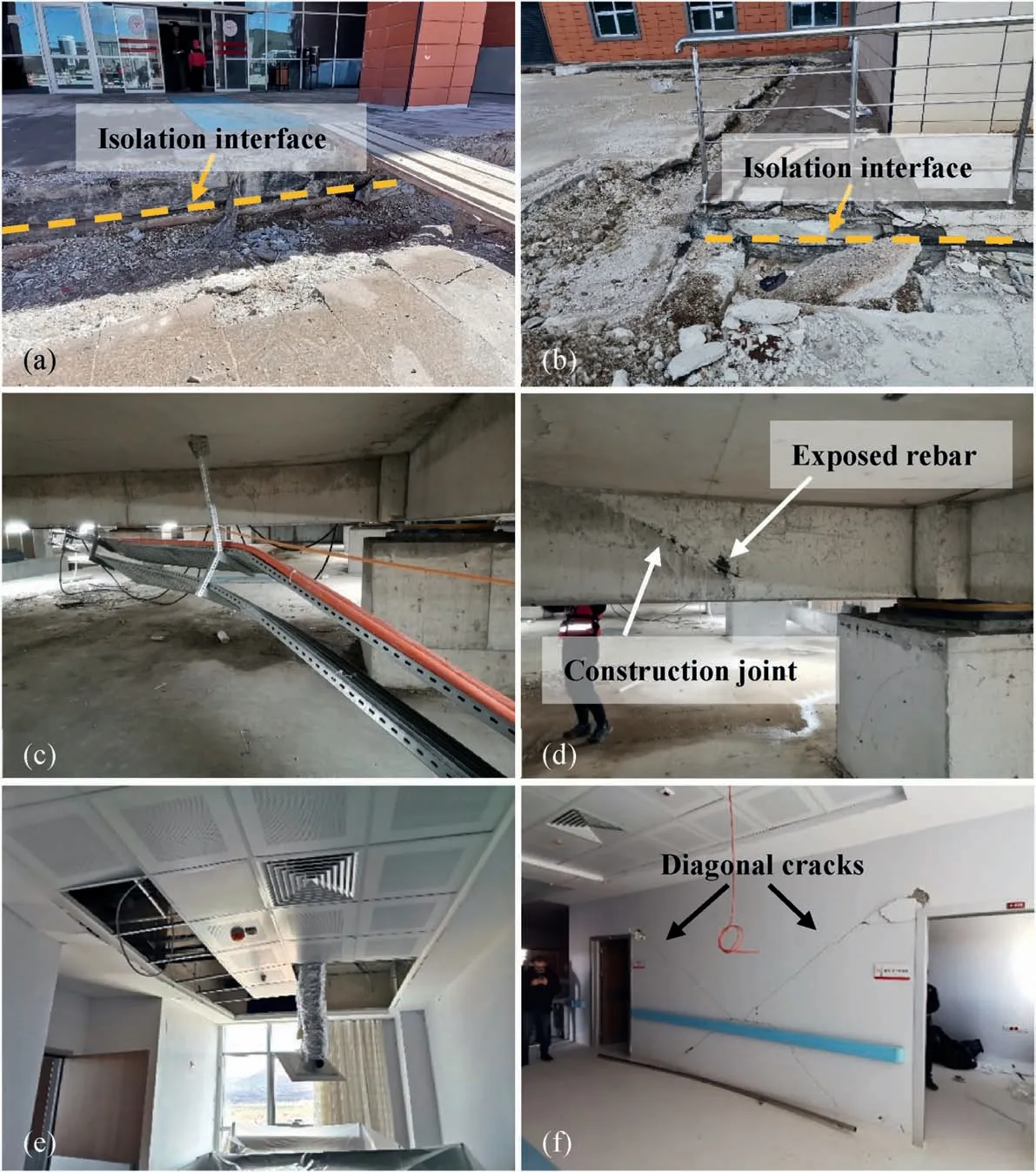
Fig.14.Observed damage to base-isolated building B3 of the Doğans¸ehir State Hospital: (a) re-excavated isolation gap at the main entrance, (b) exposed isolation interface around a corner, (c) falling of cable tray in the isolation layer, (d) sign of the poor quality of concrete pouring in the isolation layer, (e) damage to the suspended ceiling in the superstructure and (f) diagonal cracks on a masonry infill in the superstructure.
Probably because of the blocking of the isolation layer, disproportionate nonstructural damage was observed in the superstructure of the building.It included the widespread damage to the suspended ceilings(Fig.14(c)) and the extensive cracking of masonry infills (Fig.14(d)).They are the two types of most commonly seen nonstructural damage often observed in non-isolated buildings(Kanda et al.,2021).As a result of such nonstructural damage,the occupancy of B3 remained suspended upon our visit on March 30,2023.
3.3. Other successful examples of immediate occupancy: B4 and B5
B4 is a base-isolated building of the Elbistan State Hospital with 378 beds (Elbistan Devlet Hastanesi, 2023).It was constructed in 2017 and had a block of 3 stories in the front and another block of 9 stories above the ground in the back(Fig.15(a)).
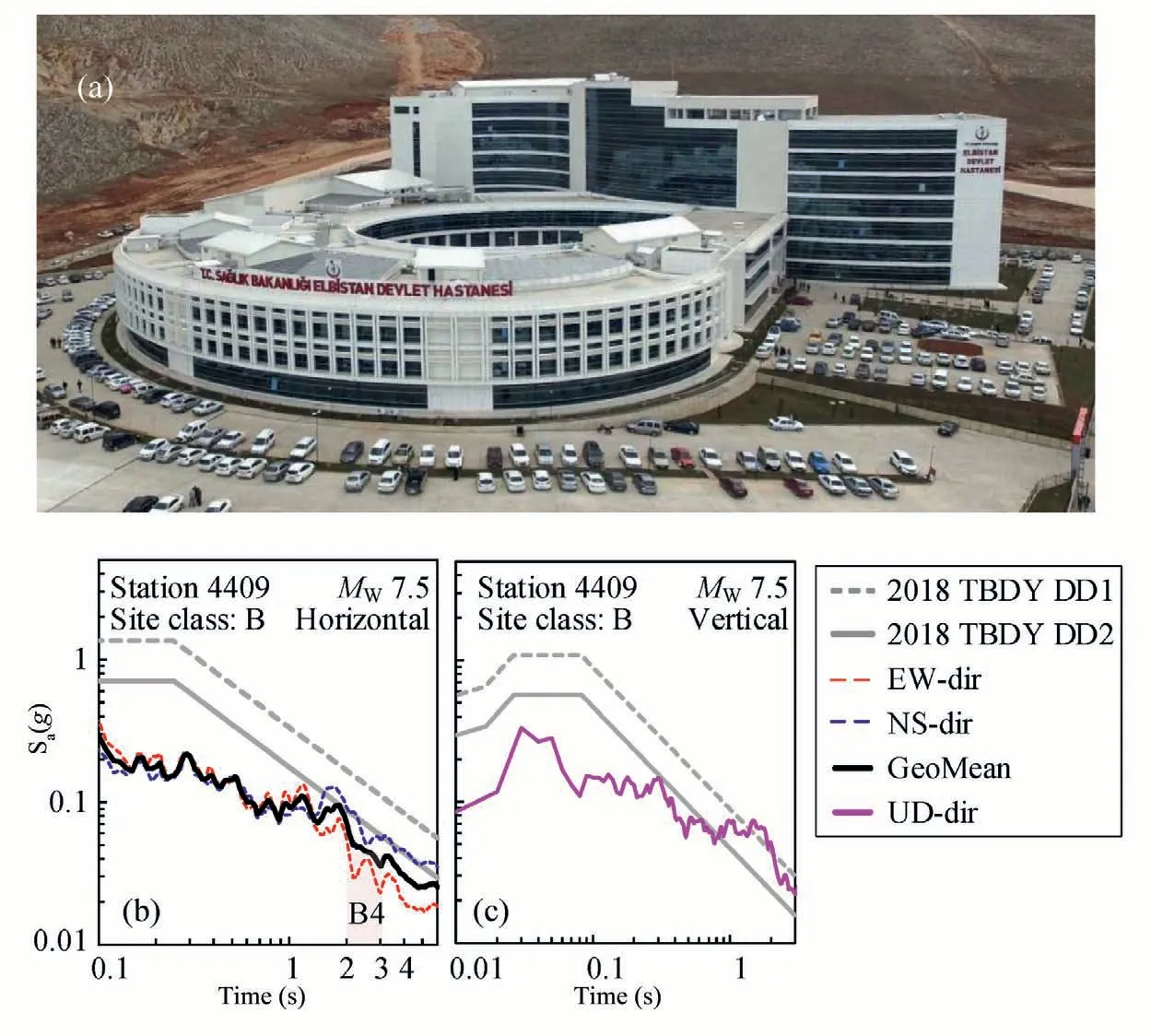
Fig.15.(a) Arial view of B4 of the Elbistan State Hospital (Kahramanmara¸s Valiliği, 2023), the response spectra of the 4409 record in the MW 7.5 event in(b) horizontal and (c) vertical directions (5% damping).
It was 20 km from the epicenter of theMW7.5 event.The closest strong motion station was Station 4628 in Afs¸in,which was 21 km to the east of the hospital (Fig.4).Unfortunately, it did not obtain a strong motion record during theMW7.5 event.The second closest strong motion station to the hospital was Station 4409.It was approximately 50 km to the northeast of Building B4 and was on the same side of the fault rupture(Fig.4).Its response spectra suggest a 20% lower-than-the-DD2-level horizontal shaking within the 2–3 s period range ([Fig.15(b))].The actual ground shaking experienced by B4 should have been stronger than it.
Both blocks of B4 rested on top of an isolation layer of 455 FPBs in the basement,which was occupied as administrative offices.Most FPBs in the isolation layer were hidden behind nonstructural elements and only one near a staircase was exposed for visitors to acknowledge the seismic isolation technology (Fig.16(a)).A first glance gave an impression that the isolator was blocked by a girder, which was in fact a thin gypsum board for decoration (Fig.16(b)).According to the manager of the hospital, the gypsum board, together with other nearby nonstructural elements, was broken by the deformation of the isolator during the earthquake but has been repaired soon after the earthquake.Despite this alleged nonstructural damage in the basement, the operation of the hospital was recovered immediately after the earthquake.Other minor damage to the building included the dislocation of some segments of the sealing plates around the isolation interface(Fig.16(c)and(d)).
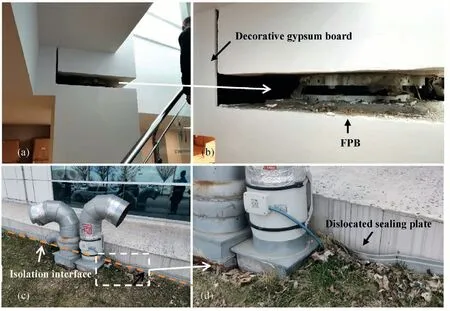
Fig.16.Minor damage to B4: (a) and (b) exposed FPB, (c) isolation interface, and (d) dislocated sealing plate.
B5 is the base-isolated building of the Dörtyol State Hospital with 450 beds in Hatay Province (Dörtyol Devlet Hastanesi, 2023).It was approximately 86 km to the southwest of the epicenter of theMW7.8 event and approximately 25 km to the east of the fault rupture (see Fig.1).Only 0.9 km to the east of the hospital was Station 3134,which obtained a strong motion record during theMW7.8 event (Fig.17(a)).The record had a peak ground velocity(PGV)of 40 cm/s in the horizontal direction.Its spectra suggest that the horizontal shaking was approximately 2.5 times the DD2-level intensity within the period range of 2–3 s(Fig.17(b)).The response spectrum in the vertical direction reached the DD1-level around the period of 1 s (Fig.17(c)).
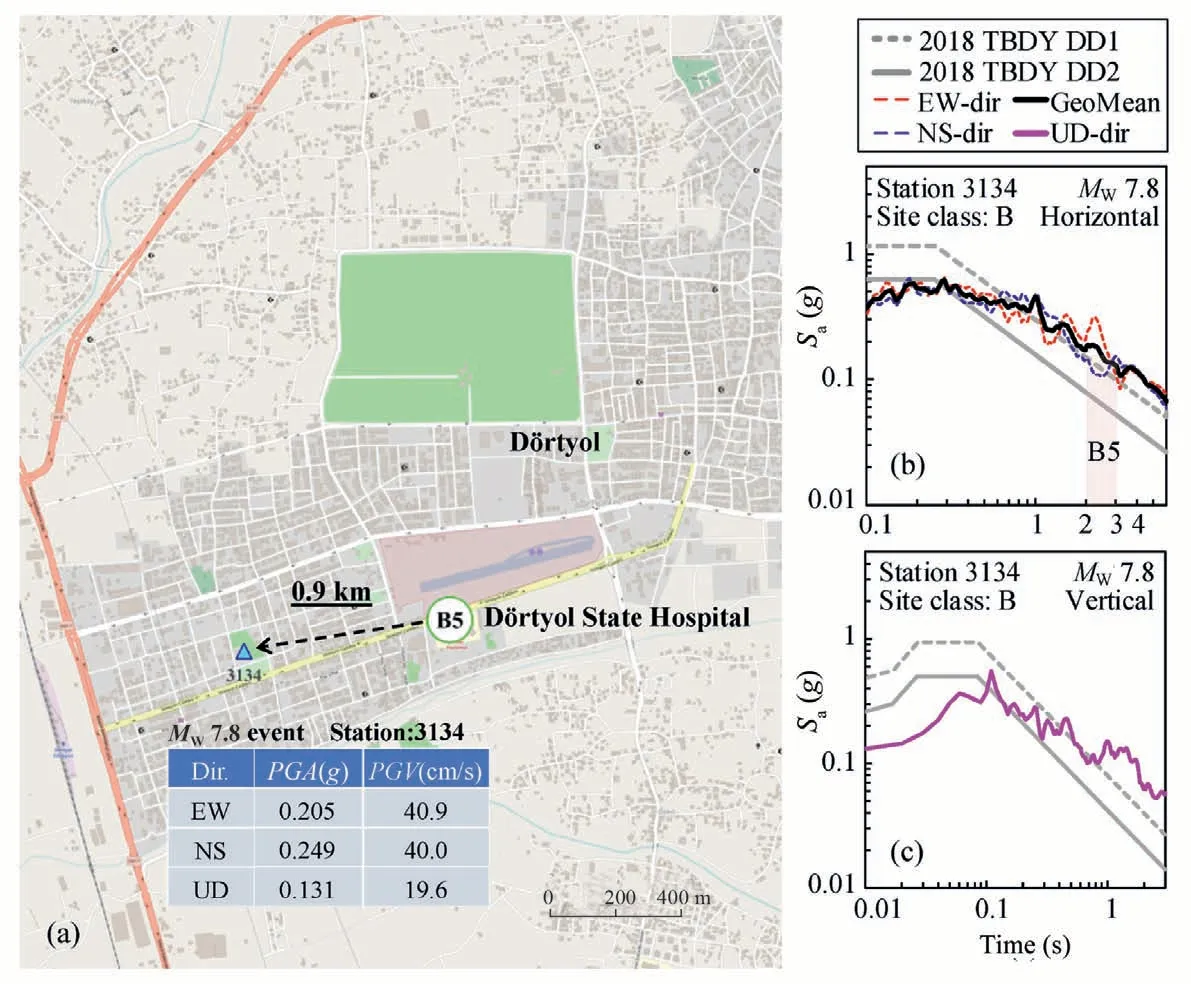
Fig.17.(a) Locations of B5 of the Dörtyol State Hospital and nearby strong motion station 3134, and the response spectra of the 3134 record in the Mw 7.8 event in(b) horizontal and(c) vertical directions (5% damping).
The base-isolated B5 building was constructed in 2019 and had two 3-story blocks in the front and another 10-story block above ground in the back(Fig.18(a)).The building was seismically isolated by 340 FPBs of a design stroke of plus/minus 400 mm.Their vertical load-bearing capacities range from 400 to 4110 tons depending on their diameters(TS,2023d).The isolation layer was not occupied for any other functions(Fig.18(b)).A video showed that the shaking of the building was felt by the occupants during the earthquake, who fled form the building with fear(Habertürk,2023).Nonetheless,the building received little damage during the earthquake,and the operation was immediately resumed after the earthquake.The only sign of damage was the crushed edges of some tiles on the cover plate over the isolation gap (Fig.18(b)).In addition,there were also signs of residual deformation of several millimeters in multiple FPBs[Fig.18(d)].
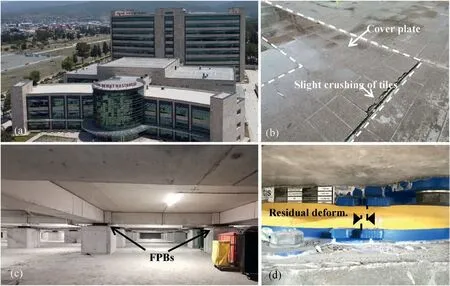
Fig.18.The isolated building B5 of the Dörtyol State Hospital: (a) arial view (TS, 2023d), (b) slight crushing of tiles on the cover plate over isolation gap, (c)basement for isolation layer, and (d) an FPB in the isolation layer.
4.Fixed-base hospital buildings
4.1. Hospital buildings within 2 km of the fault rupture: F2, F3, F4, and F5
The southwestern segment of the fault rupture of theMW7.8 event was in a region of dense strong motion stations.The survey team visited four hospitals along the fault rupture.They were all fixed-base buildings constructed after 2001 and were within 2 km from the fault rupture of theMW7.8 event.They are labeled as F2 to F5 according to their locations along the fault rupture (Fig.1).This section introduces their post-quake occupancy status and observed damage if there was any.
The F2 building of the Nurdăgi State Hospital in Gaziantep Province was approximately 31 km to the east of the epicenter of theMW7.8 event,the closest to the epicenter among the four hospitals of concern in this section (Fig.1).The small city of Nurdăgi was almost destroyed by the strong shaking of the earthquake (Haberler, 2023).The town was known to have a high seismic risk before the earthquake.The DD1-level maximum spectral acceleration is as high as 2.1gfor site class ZB as per the seismic code (TBDY-2018, 2018).Although very strong, the ground motion record by the nearby Station 2712 exhibited a horizontal spectral acceleration lower than the expected DD1-level spectrum at the estimated fundamental period of Building F2 (Fig.19(b)).Nonetheless, it exceeded the DD2-level spectrum by 1.59 times.
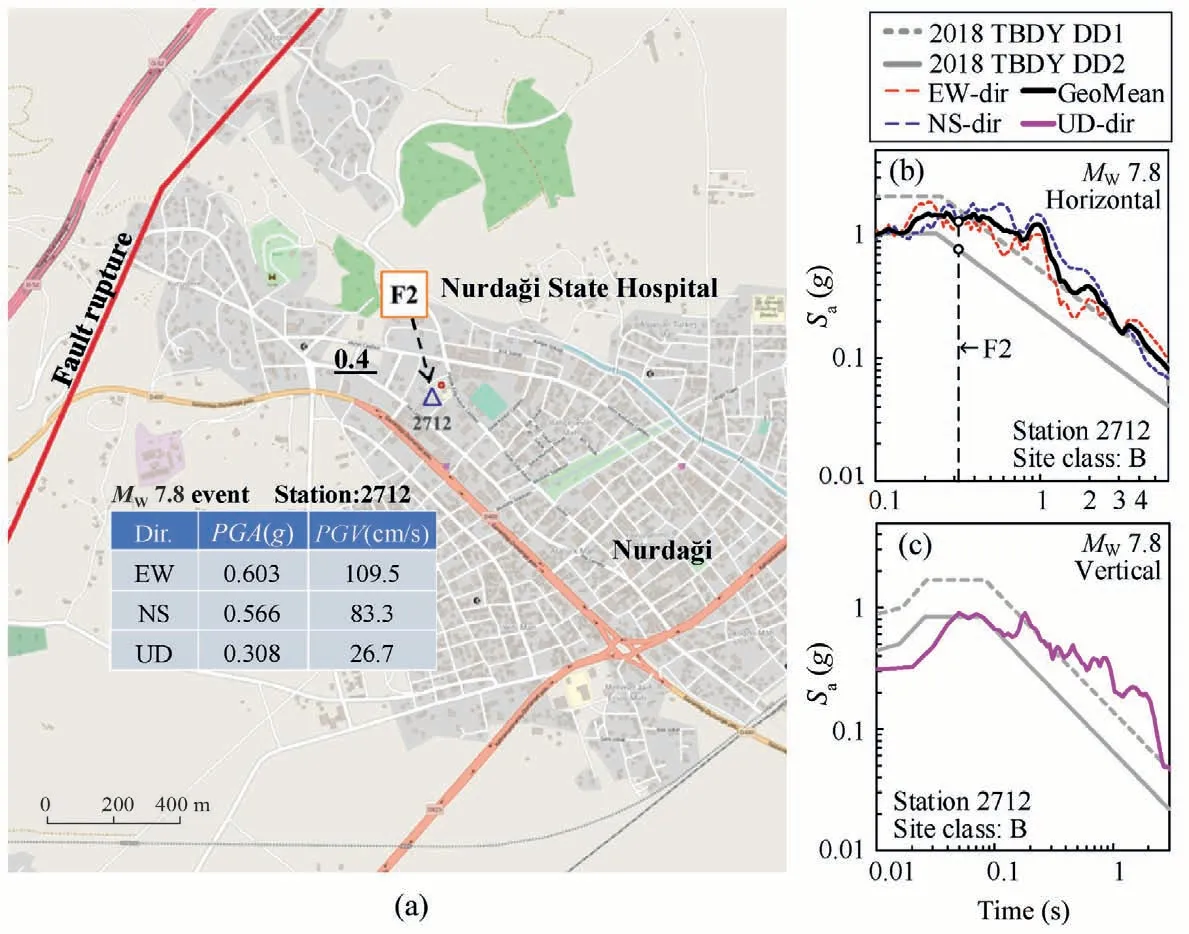
Fig.19.(a)Locations of F2 of the Nurdăgi State Hospital and nearby strong montion station 2712,the response spectra of the 2712 record in the Mw7.8 event in(b)horizontal and (c) vertical directions (5% damping).
Under such shaking,the 2-story RC frame hospital building,originally constructed in 2003 and uplifted in 2015(Nurdăgi District State Hospital,2023),sustained extensive nonstructural damage while little damage was observed on the structural members.Outside the building, the dry hanging stone curtain walls on the façade were almost destroyed(Fig.20(a) and (b)).Inside the building, the debris of damaged nonstructural elements has not yet been cleaned (Fig.20(c)) but some important medical equipment has been evacuated to outdoor temporary hospitals to resume the medical service.The nonstructural damage that suspended the occupancy of the building included the extensive cracking of masonry infills(Fig.20(d)),fallen suspended ceilings(Fig.20(e)),and scattering of slid and overturned medical equipment and furniture(Fig.20(f)).
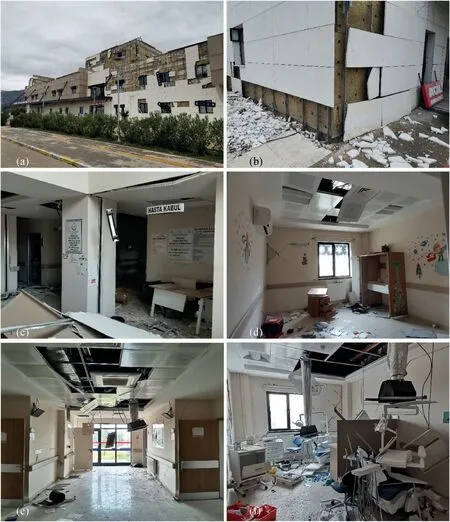
Fig.20.Nonstructural damage to the fixed-base building F2 of the Nurdăgi State Hospital: (a) façade, (b) damage to dry hanging stone curtain wall, (c) an intact concrete column in the aftermath of the entrance hall,(d)cracked masonry infills and fallen suspended ceiling,(e)damaged suspended ceiling in the 1st-floor corridor,(f) aftermath of a dental treatment room.
To the southwest along the same fault rupture was the Building F3 of theslahiye State Hospital.The closest strong motion station was Station 2718 on the other side of the small city,approximately 4.2 km away from the hospital(Fig.21(a)).The horizontal acceleration spectra of the 2718 record exhibited a demand ratioDR=1.62 for F3 but did not exceed the DD1-level(Fig.21(b)).
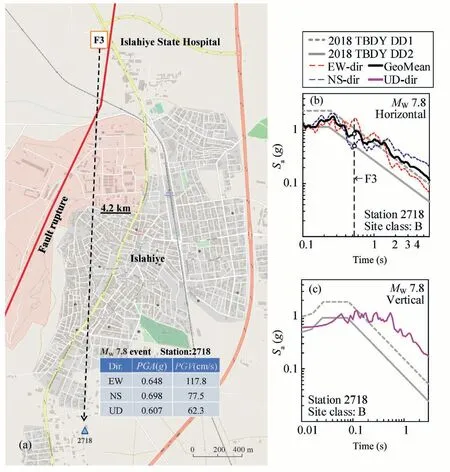
Fig.21.(a) Locations of F3 of the slahiye State Hospital and nearby strong motion station 2718, the response spectra of the 2718 record in the MW 7.8 event in(b) horizontal and (c) vertical directions (5% damping).
Despite the high demand ratio, the 4-story RC frame building F3(Fig.22(a)) sustained no visible damage to its structural elements and minimal damage to its nonstructural elements.The hospital remained operational after the earthquake.A surface rupture went through its campus and was only approximately 50 m in front of the building(Fig.22(b)).The limited damage included the falling of some stone tiles of the dry hanging stone curtain wall at the back of the building(Fig.22(c)), and some missing panels from the suspended ceiling in the lobby(Fig.22(d)).
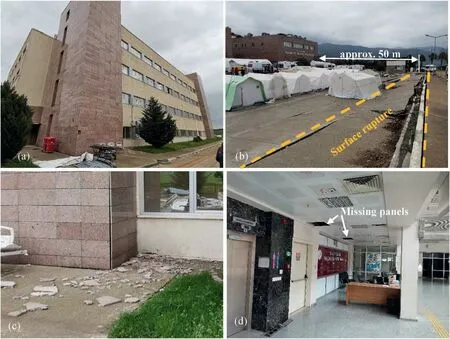
Fig.22.(a) Rearview of F3 of the slahiye State Hospital, (b) distance of F3 from observed surface rupture, (c) debris of fallen pieces of stone curtain wall, and (d)some missing panels from the suspended ceiling.
Also remaining operational was the 3-story RC frame building F4 of the Hassa State Hospital in Hatay Province.It was also very close to the fault rupture.Station 3138 was in its vicinity but on the other side of the fault rupture(Fig.23(a)).The record exhibited significant contents in the period range of around 1 s.At the 0.42 s estimated fundamental period of F4, the spectral acceleration of the record reached the DD1-level spectrum in the horizontal direction (Fig.23(b)).
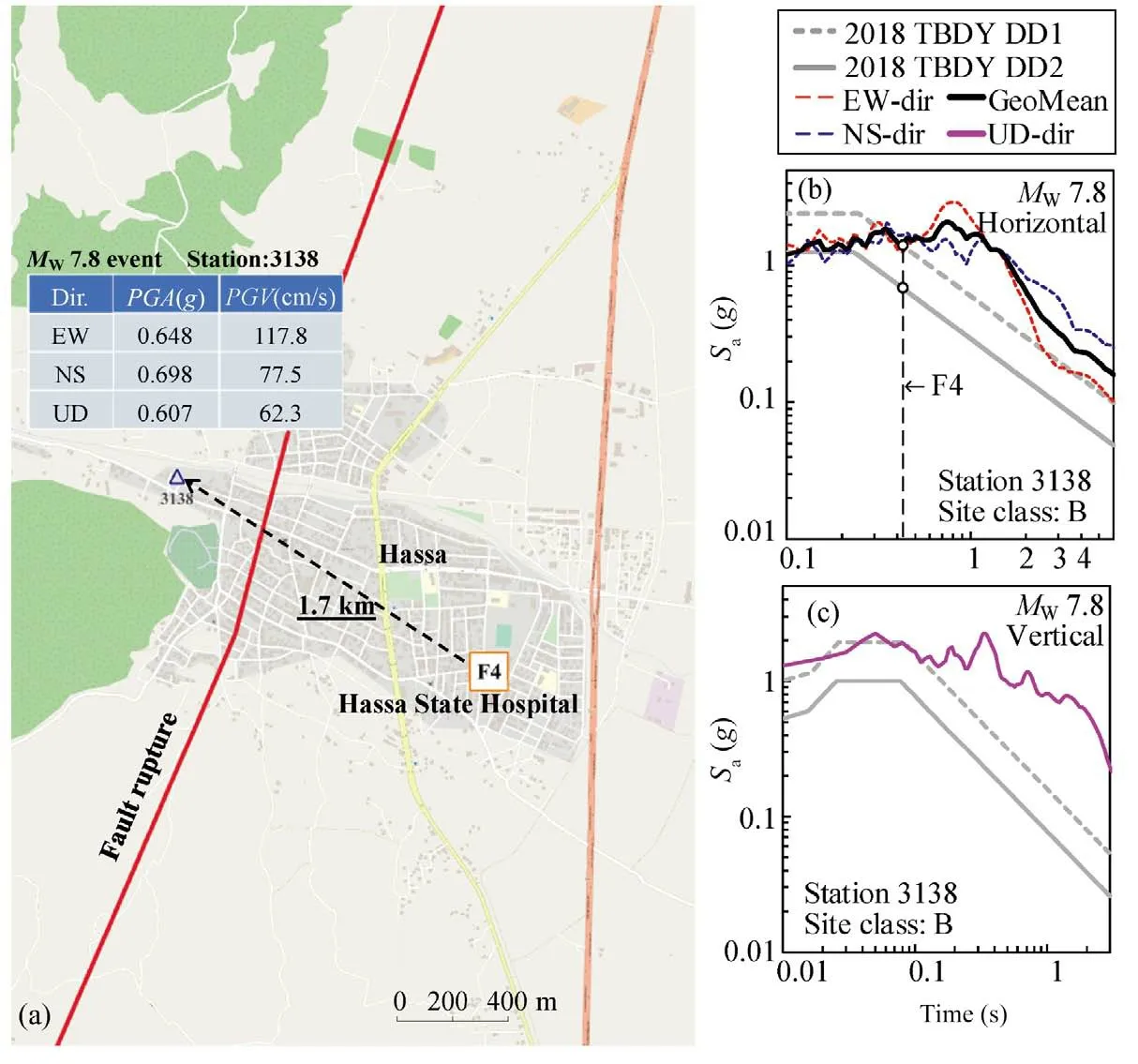
Fig.23.(a)Locations of F4 of the Hassa State Hospital,and nearby strong motion station 3138,and the response spectra of the 3138 Record in the Mw7.8 event in(b)horizontal and (c) vertical directions (5% damping).
The building built in 2022 seemed to have sustained no visual damage when we visited on March 26, 2023.The service of the hospital was fully resumed (Fig.24).In comparison, an old hospital building on the same campus was badly damaged and its access has been restricted.
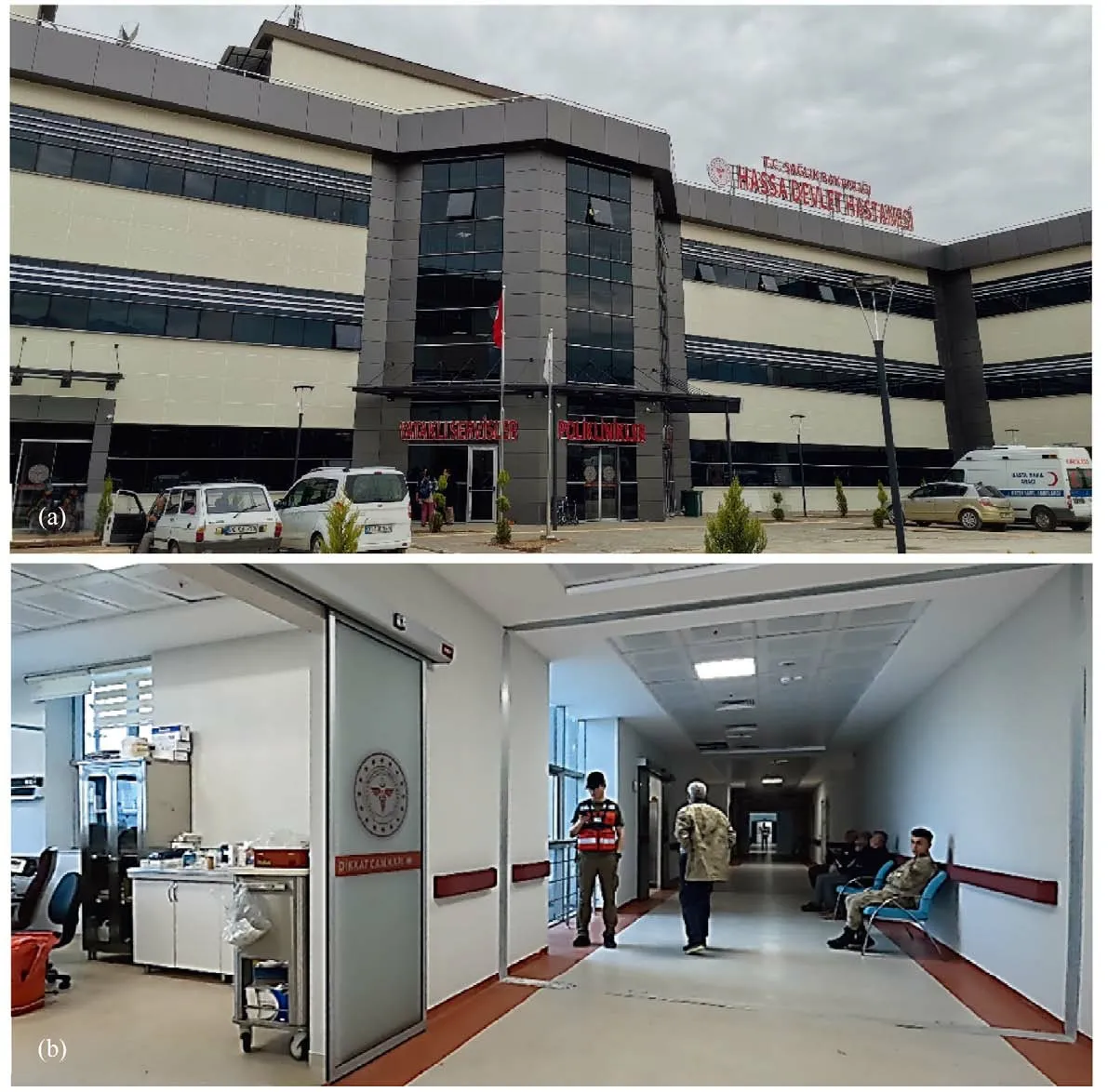
Fig.24.Building F4 of the Hassa State Hospital: (a) façade and (b) interior view on 26 March 2023.
The performance of both F3 and F4 provided successful example of fixed-based buildings achieving the goal of immediate occupancy under high seismic demands.However, the contrast behavior with F2, which was also built in recent years but became unoccupiable because of extensive nonstructural damage, requires further investigation for the possible reasons.Such an investigation may improve the understanding of the seismic behavior of hospitals and therefore help enhance the seismic resilience, but is out of the scope of this rapid report.
Building F5 of the Hatay Education and Research Hospital was close to the southwestern end of the fault rupture of theMW7.8 earthquake(see Fig.1).It was approximately 9 km to the northeast of the city center of Hatay.The city was among the most badly damaged areas in the earthquake.The building damage there was especially heavy on the alluvial plain along the river.
The closest strong motion station from the hospital was Station 3124,which recorded a 0.636g PGAin the EW component and a 113.1 cm/sPGVin the NS component (Fig.25(a)).The spectral acceleration in the horizontal direction much exceeded the DD1-level spectrum in a wide range of periods and resulted in an extremely highDRof 5.14 at the estimated fundamental period of F5 (Fig.25(b)).
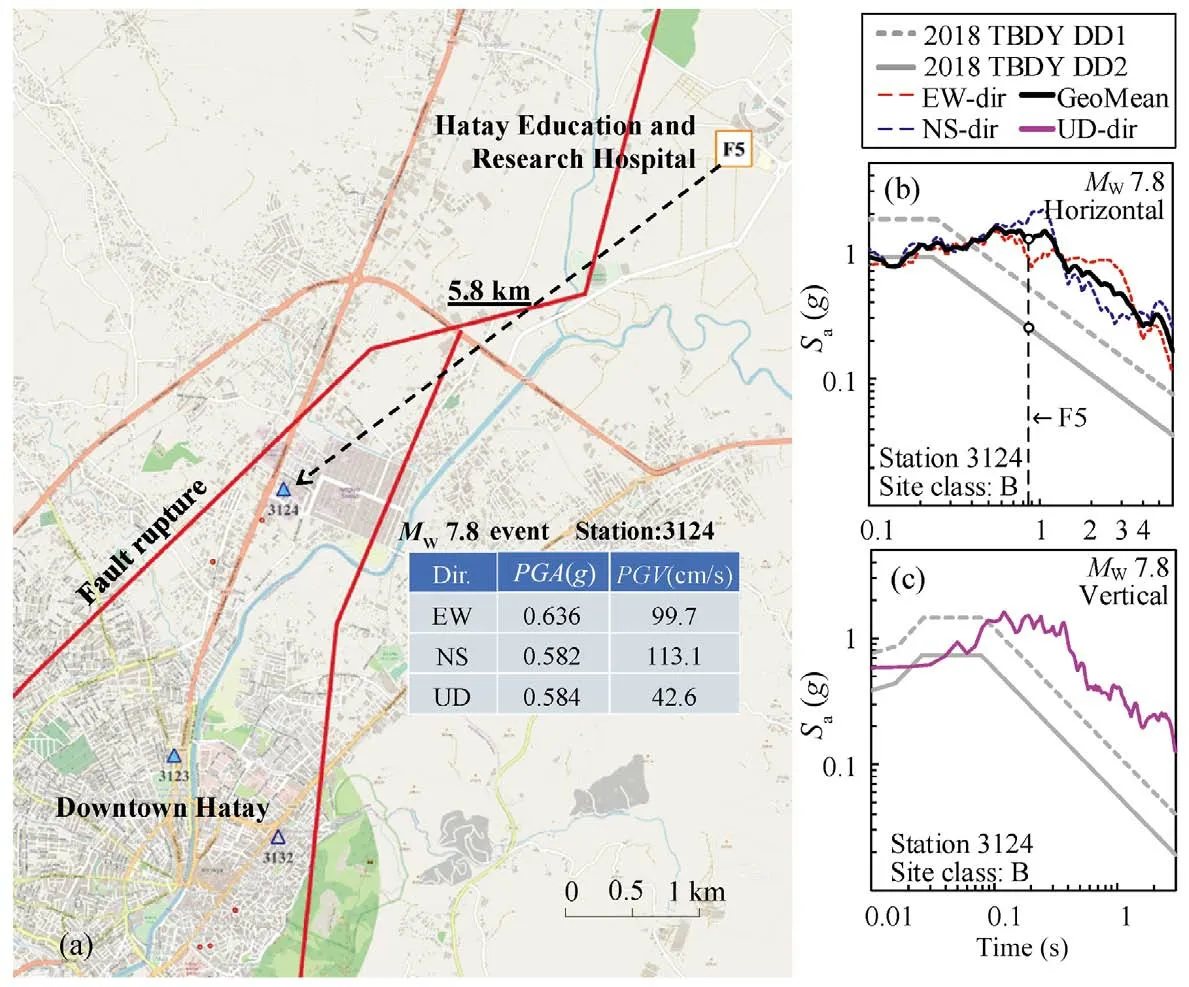
Fig.25.(a) Locations of F5 of the Hatay Education and Research Hospital, and nearby strong motion station 3124, the response spectra of the 3124 Record in the MW 7.8 event in (b) horizontal and (c) vertical directions.
The Hatay Education and Research Hospital is the largest hospital in Hatay Province.It has 1130 beds.The F5 building was constructed in 2001 and uplifted in 2013 (Hatay Education and Research Hospital,2023).Despite the exceptionally high demand ratio of more than 5, the building remained standing after the earthquake and successfully achieve the goal of collapse prevention.The glass curtain wall in the front façade seemed intact except for some minor damage at the expansion joints(Fig.26(a)).Nevertheless, severe damage to some of the structural members could be observed from outside (Fig.26(b) and (c)).Nonstructural damage such as the failure of masonry infills was also extensive (Fig.26(d) and (e)).

Fig.26.Damage to F5 of the Hatay Education and Research Hospital:(a)front façade,(b)exposed rebars at the base of a flat column,(c)buckled rebars at a column end, (d) out-of-plane damage to a masonry infill and (e) extensive cracking to masonry infills.
4.2. Old buildings constructed before 2001: F6 and F7
The seismic performance of buildings constructed after 2001 in Turkey is generally believed to be much better than that of older buildings as a result of the following four factors (Binici et al., 2023): (1) the enforcement of a modern seismic design code in September 1998 (Soyluk and Harmankaya, 2012); (2) the alarms by the deadlyMW7.6zmit earthquakes in August and theMW7.2 Düzce earthquake in November 1999; (3) the enforcement of a modern code for concrete structures (TS-500) in October 2000 (TS-500, 2000); and (4) the enforcement of the Building Inspection Law in July 2001 (Özden and Erkılıç, 2015).All the hospital buildings introduced in the proceeding sections were built after 2001.In this last section, we introduce the observed damage to two older hospital buildings that were constructed before 2001.Both buildings were low-rise RC frame structures in Hatay Province.They are labeled as F6 and F7 in Fig.1.
F6 was constructed in 1968.It hosted theskenderun State Hospital with 318 beds in the harbor city ofskenderun.Approximately 6.3 km from the hospital, Station 3316 obtained a strong motion record in theMW7.8 event that provided a reference for the shaking experienced by F6 (Fig.27(a)).Although poor in very short-period contents, the record exhibited a horizontal spectral acceleration between the DD2 and DD1 levels in a wide range of period (Fig.27(b)).F6 sustained severe structural damage under the strong shaking.A block in the middle of the building collapsed and was being demolished during the earthquake(Fig.28).The whole building was to be demolished according to the local staff.
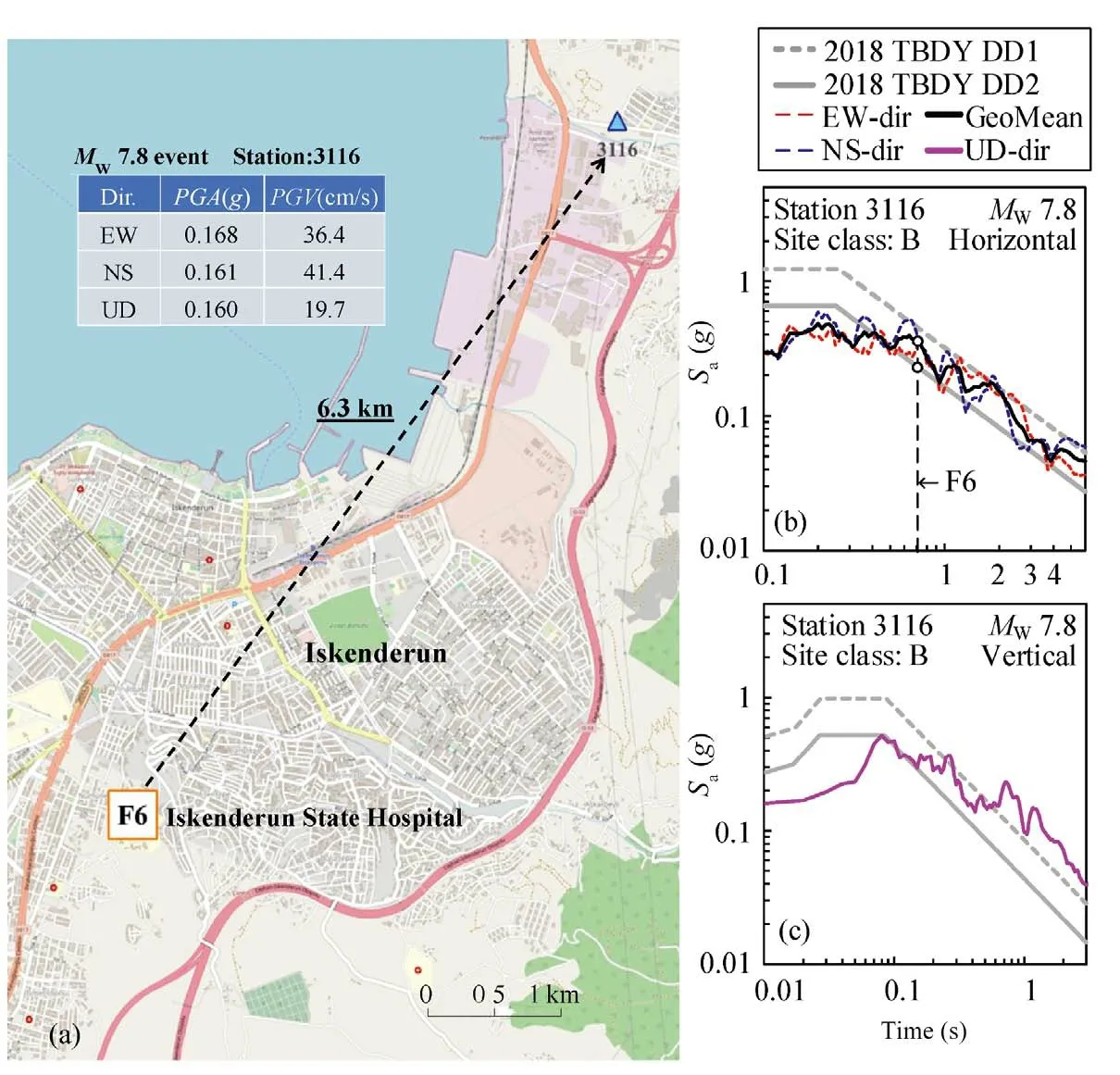
Fig.27.(a)Locations of F6 of the skenderun State Hospital and nearby strong motion station 3116,the response spectra of the 3116 Record in the MW7.8 event in(b)horizontal and (c) vertical directions (5% damping).

Fig.28.Building F6 of the skenderun State Hospital: (a) main entrance, (b) location of the collapsed block, and (c) debris of the collapsed block.
F7 was constructed in 1994.It hosted the Erzin State Hospital of 50 beds.It was 12 km to the north of the base-isolated building B5.Station 3134 near B5 was the closest strong motion station to it (Fig.1).As shown in Fig.29, the spectral acceleration of the 3134 record at the estimated fundamental period of F7 was close to the DD2-level spectrum.It was prohibited to access the building when we visited it.From outside the building,the observed damage included the collapsed wooden roof,RC column hinging at the bottom end,and extensive cracking of masonry infills at the bottom story(Fig.30).Like in the Nurdăgi State Hospital,the medical equipment in F7 has been evacuated to outdoor temporary hospitals.
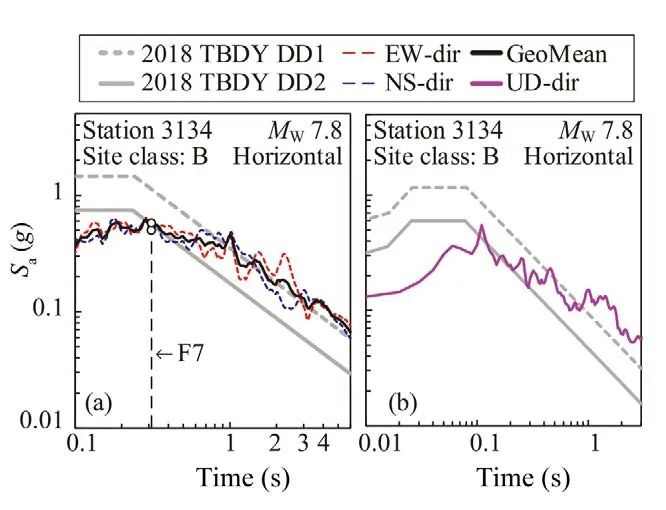
Fig.29.Response spectra of the 3134 record in the MW 7.8 event in(a) hori-zontal and (b) vertical directions (5% damping).
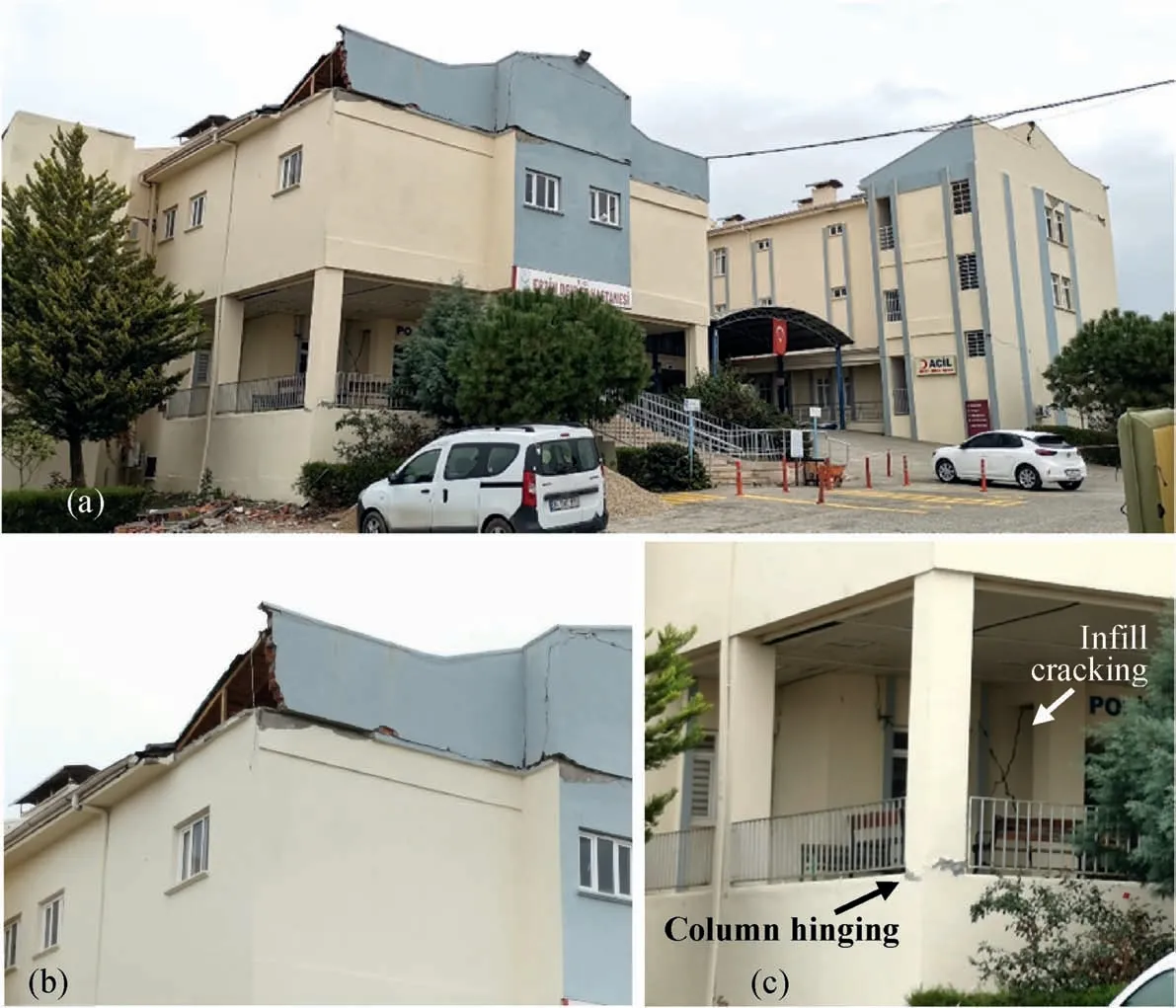
Fig.30.Damage to F7 of the Erzin State Hospital:(a)front view,(b)collapsed wooden roof and(c)observed column hinging and masonry infill cracking from outside the building.
5.Conclusions
This report summarizes the seismic damage to 12 hospital buildings in the seven provinces in southcentral Turkey that were most heavily affected by the February 6,2023 earthquake doublet.It endeavors to put the observed post-quake occupancy status of the hospitals in the context of their respective seismic demands according to the nearby strong motion records obtained during the earthquakes.By normalizing the seismic demand with the capacity of the building in terms of spectral accelerations,a demand ratio was defined to show that most of the investigated buildings experienced a stronger-than-design-basis level earthquake.
The base-isolated hospital buildings on friction pendulum bearings generally exhibited superior performance in achieving the goal of immediate occupancy by providing better protection for nonstructural elements.In Malatya,the contrast post-quake occupancy statuses of a baseisolated building(B1)and a fixed-base building(F1)on the same hospital campus provided an example of such successful protection by base isolation.However, improper detailing of the nonstructural elements in the base isolation layers,such as the masonry infills,isolation gap,and its cover plates, led to damage in some of the base-isolated buildings.
Although inferior to base-isolated buildings in terms of immediate occupancy,the fixed-base hospital buildings of RC structures constructed after 2001 successfully achieved the goal of collapse prevention even under a seismic demand of more than 5.It was also curious to observe two fixed-base hospitals (F3 and F4) to remain operational after the quakes even if they were very close to the fault rupture and were likely to have been subjected to higher-than-design-level earthquake ground motions.
It should be beard in mind that the estimated demand ratios were merely rough estimates that were intended to provide more information when interpreting the observed damage and post-quake statuses.They are subjected to a variety of uncertainties as summarized at the end of Section 2.Thorough investigation and in-depth analyses are pending to gain insight into the observed phenomena, especially those of the immediately occupiable fixed-based (e.g., F3 and F4) or seemingly uninitiated base-isolated(e.g.,B2)hospitals under a high demand.It would be of great value for enhancing community resilience against future earthquakes.
Author agreement and acknowledgment
All the authors who contributed to the study have approved the final version.This is the first time submitting to this journal and also do not consider submitting to other Journals.And we would like to give permission to the publisher to reproduce this paper in all media.
The contents of this report are based on a reconnaissance survey organized by the China Earthquake Administration (CEA).The Turkey Disaster and Management Authority (AFAD) provided the letter of a permit for the reconnaissance team to enter the earthquake-affected area.The first author of this report was the director of the team for earthquake disasters.The team members include Professors Junwu Dai, Yongqiang Yang, Xiangzhao Chen, and Xiaoting Wang from the Institute of Engineering Mechanics, CEA, Professor Zhiguang Zhou from Tongji University, and Professors Xiwei Fan and Wenhua Qi from the Institute of Geology, CEA.The authors also appreciate Mr.Yesilboya Ömer from AFAD for his accompany during the whole survey and his assistance in accessing the hospitals.The survey was jointly sponsored by the Institute of Engineering Mechanics and the Natural Science Foundation of China(No.52122811).The financial support is appreciated.
Declaration of competing interest
The authors declared that they have no conflicts of interest to this work.
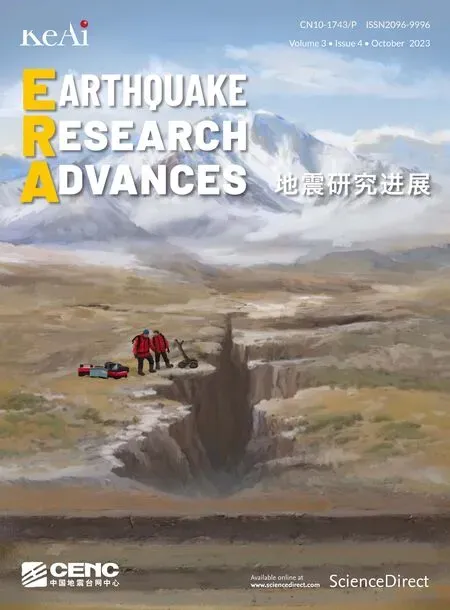 Earthquake Research Advances2023年4期
Earthquake Research Advances2023年4期
- Earthquake Research Advances的其它文章
- Rupture process of the January 8, 2022, Menyuan M 6.9 earthquake
- Seismicity and seismogenic mechanism of the MS 6.0 Luxian earthquake on September 16, 2021
- Propagation of crust deformation anomalies related to the Menyuan MS 6.9 earthquake
- Trade space for time for inspecting an earthquake cycle by modern seismological observation:The central-southern part of the Sichuan-Yunnan rhombic block
- Earthquake geochemical scientific expedition and research
- Introduction to the recently published treatise entitled A Guidebook to Earthquake Scientific Investigation
